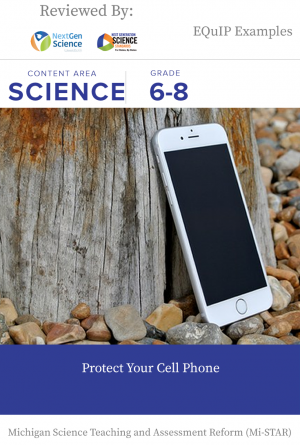
Mi-STAR is an integrated science middle school curriculum and teacher professional learning program designed for the Next Generation Science Standards. Mi-STAR stimulates students’ engagement through real-world unit challenges that demonstrate how science and engineering contribute innovative solutions to contemporary problems. Mi-STAR’s curriculum incorporates three-dimensional assessments and the professional learning program includes technology-enabled networking. Mi-STAR is empowering teachers to improve students’ science learning. Mi-STAR was founded in 2015 through generous support provided by the Herbert H. and Grace A. Dow Foundation. Mi-STAR has also received substantial support from the National Science Foundation, the MiSTEM Advisory Council through the Michigan Department of Education, and Michigan Technological University.
Score: 6
Science Discipline: Physical Sciences, Engineering, Technology, and Applications of Science
Length: Unit
Year Reviewed: 2021
All Mi-STAR units focus instruction around a challenge that students must address as they work their way through the unit’s storyline. The storyline for this unit centers on students helping a friend who keeps breaking his phone. The friend can’t get a new phone unless he (with our help) can explain the science behind the forces causing damage and the engineering required to design a home-made case that will protect the new phone. Can you meet this challenge?
In the unit, students explore how a case can protect a cell phone from the forces when it is dropped or crushed under something, and use engineering practices to design a cell phone case to meet specific criteria and constraints. Throughout the unit, students use hands-on experiences and systems modeling to explore properties of force and motion, while planning fair investigations for their cell phone case designs.
In order for students to successfully solve the cell phone case challenge, they first learn how to represent forces as vectors with a magnitude and direction and identify the equal and opposite forces acting during interactions between two objects. Students then identify balanced and unbalanced forces on single objects by testing paper towers they design themselves. They learn about the components of a fair test, while exploring the effects of mass and force on the acceleration of pennies. Students investigate the distribution of forces during collisions as they drop eggs onto various cushioned surfaces. Finally, students look closely into a complex collision scene. Using specific frames of reference, they identify the direction and magnitude of forces in a compiled systems-model mural. All of these learning experiences help students act as engineers to design and test their own phone cases using systematic methods. Their content knowledge, test results, and design are all communicated to others at the culmination of the unit.
Link to Materials
6.4 Protect Your Cell Phone: Forces and Motion
A previous version of this unit was reviewed by the Science PRP and was posted here with a Example of High Quality NGSS Design If Improved rating. This unit has been revised based on that feedback.
 Reviews & Questions
Reviews & Questions
No comments submitted